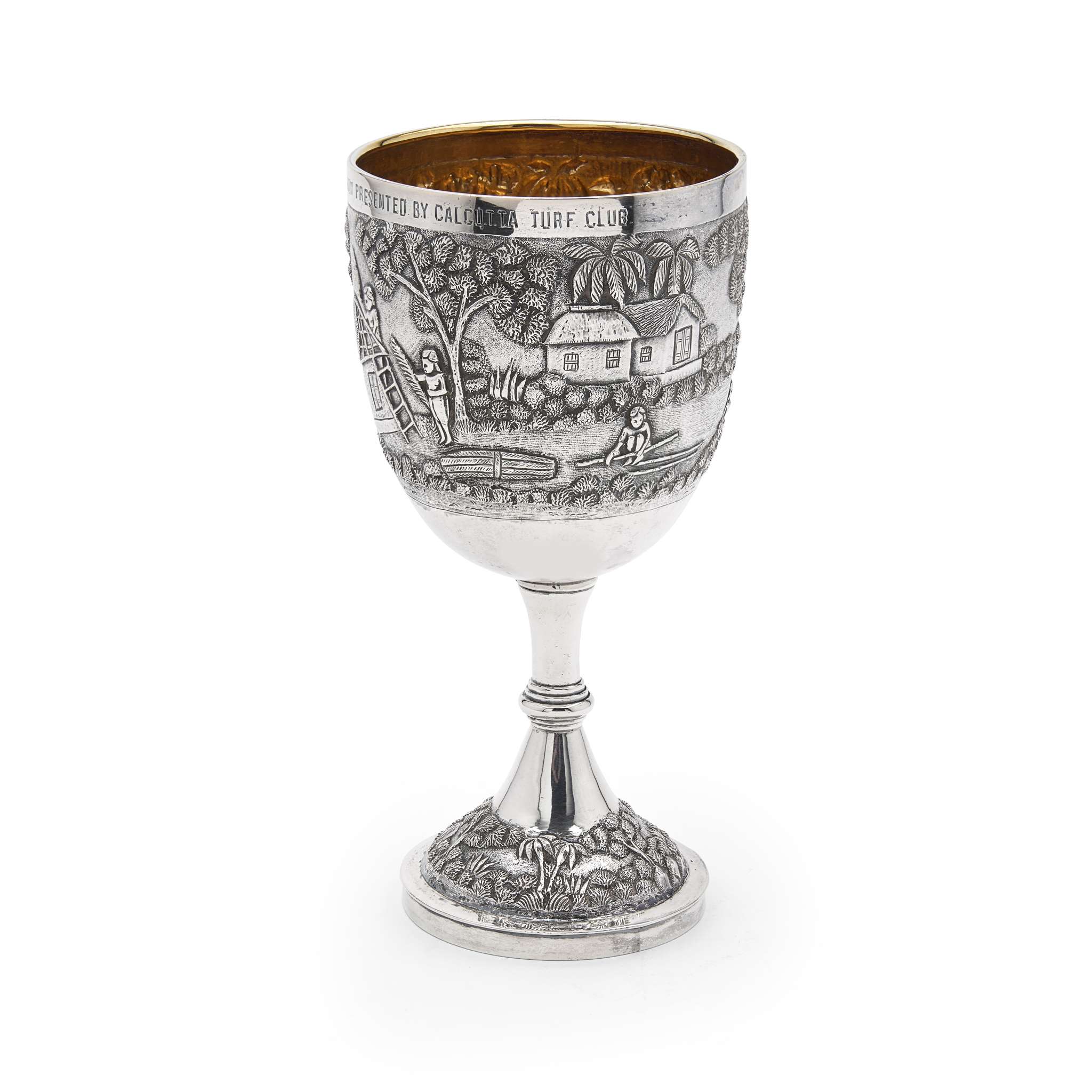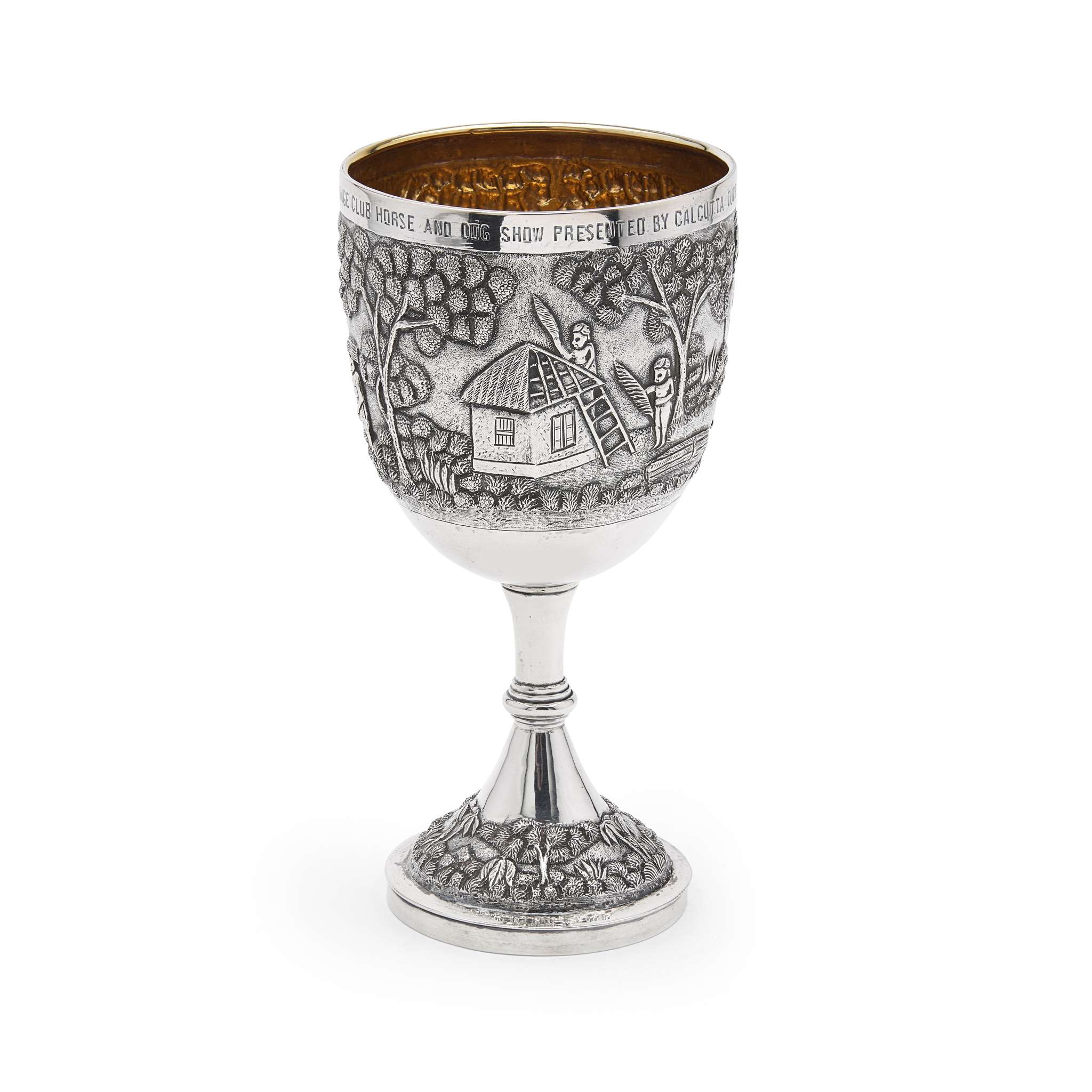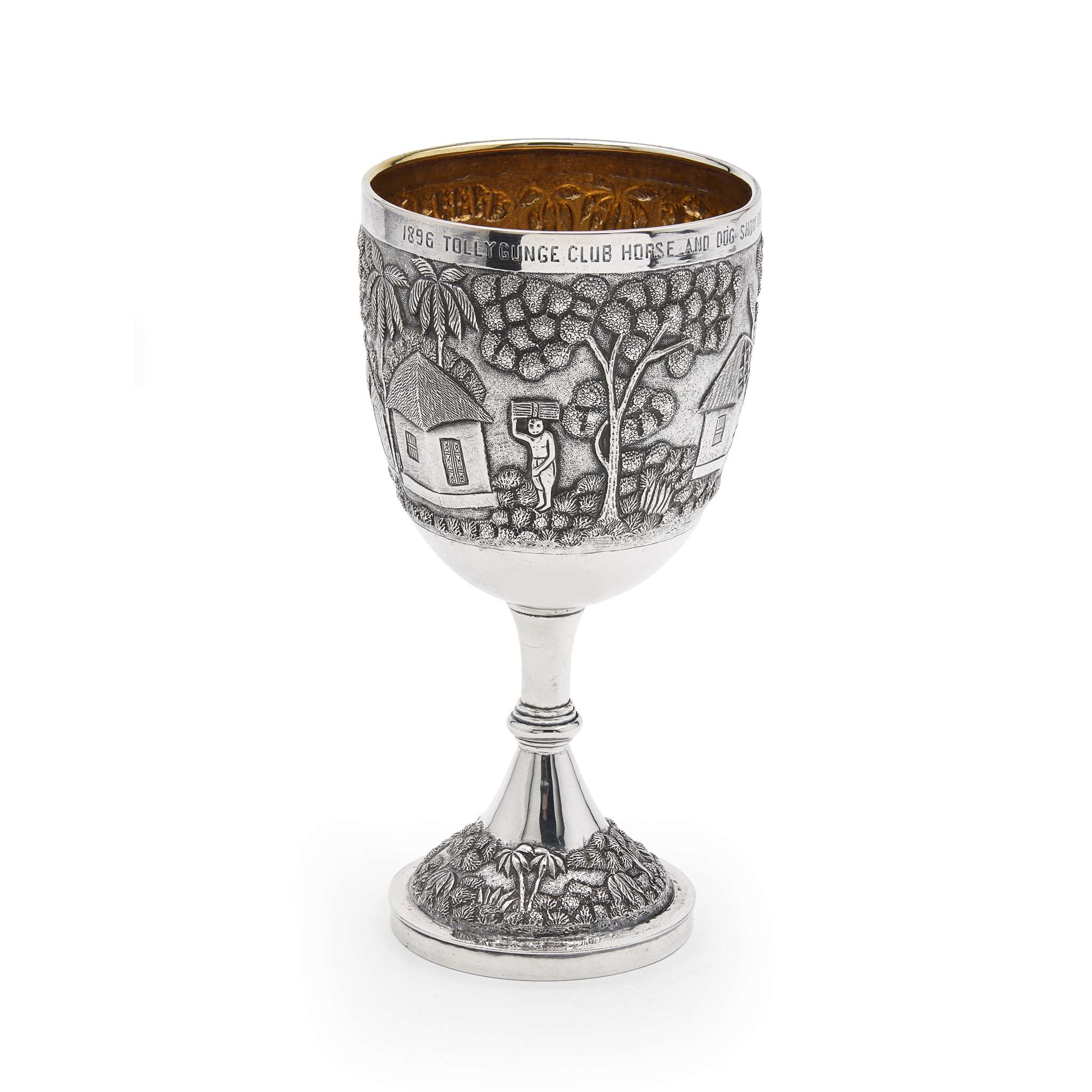1
CALCUTTA - AN INDIAN PRESENTATION ‘TURF CLUB’ TROPHY
UNMARKED, LATE 19TH
The deep bowl with gilt interior and a heavily chased depiction of pastoral life, the border, engraved ‘1896 TOLLYGUNGE CLUB HORSE AND DOG SHOW PRESENTED BY CALCUTTA TURF CLUB’ to a knopped stem and domed circular foot with similar chased decoration
18.3cm high, 9oz
Still in existence, the Tollygunge Club was founded in 1895 for British Merchants by the Scottish banker, Sir William Dixon Cruickshank (1845-1929). A portrait of him is in the collection of the National Gallery, London by H. Walter Barnett (NPG x45266), The club was originally opened as an equestrian institution and focused mainly on riding and equestrian endeavours a clear link to this cup, only a year after its opening. The club still hosts annual animal shows where members bring their pets to compete for prizes.Further literature: Pradip and Amita Das, `The Tollygunge Club Since 1895’ 2088IntroductionLyon & Turnbull is delighted to offer a collection of 19th and early 20th-century Indian silver composed over the last twenty years by Fiona Buchanan. Despite having an interest in silver and antiques from an early aged, fueled by trips to the bustling Portobello Road and Edinburgh’s small weekly auctions it took some time to fall on her preferred subject, Indian silver. Fiona’s interest was first in this area piqued after discovering a collection of silver at the Midlothian auction house Thomson Roddick & Metcalf in 2007. With a keen eye, Fiona was able to discern that the collection was in fact of Indian origin, and showcased the work of the continent her family knew well, perhaps through osmosis of the stories from her father’s time in India as a Forestry Officer at the beginning of the 20th century.The silver that forms this collection was mainly made for British expatriates during the Raj. Their tastes were taken into consideration and tableware that could be found at home was designed to suit their European styles, directly copying fashions of London and Edinburgh. However, both the craftsmen and the clientele could not help but be influenced by the various styles that each region traditionally offered, and it is this melting pot which makes Indian silver so unusual and unique. Unlike British silver which is rigorously protected by hallmark laws, the silver of India is vastly inconsistent with regards to the purity of the silver. In the late 19th century much of the silver used was from melted coinage, the rupees of the British raj did have a standard of 91.7% silver but could not always be relied upon, particularly, if for example coinage had been imported from other areas, and a mixed alloy created. Furthermore, the discovered silver in Nevada in North America was also used and shipped on a journey via England where it was refined and then found its way to Bombay, but this too was untested. It must be noted, that, on the other hand, the silverware of the region of Kutch has been analysed and rarely tests less than 96% with some artefacts testing at 98% silver, but this merely confirms the inconsistencies across the country. This purer alloy does have practical advantages meaning the silver is softer to work and create the highly embossed and finely finished designs. Silver as a craft is well regarded and the word in Hindi is derived from moonlight, meaning it has always held spiritual connotations, the respect and care can clearly be seen in the intricate designs, stretching further to those that often portray the Hindu deities.The collection highlights feature silver from the main regions of Lucknow, Madras, Kashmir, Kutch and Calcutta. Fiona visited Calcutta and even sought out the factory of Hamilton & Co., one of the most respected Indian silver firms. Identified primarily by the more austere fashion more suited to the European tastes, the highlight of the collection lot 49 the tea chest was made by this firm as well as lot 24 the sugar cane scroll holder. The seven principal regions with hybrid Indian decoration which are mentioned in Wynyard Wilkinson’s seminal publication The Silver Manufactures of India 1858–1947, are as follows; Bombay, Burma, Calcutta, Cutch, Kashmir, Lucknow and Madras. Within Fiona’s collection, Madras and Calcutta feature more with examples from well-renowned firms, Lattey Bros, Pittar & Co and even an example from the sometimes mistaken maker William Twentyman. Madras makers such as P. Orr and Smith & Kelvey have also been included in the collection, but it is the regions lesser well-known such as Alwar and Poona which show the artisan silversmithing skills more. The collection has been composed through astute auction finds and careful purchasing, particularly from auctions and with help from Jocelyn Maxton, specialist dealers of Portobello Road such as M. P. Levene and Wynyard Wilkson who has been incredibly generous with his time and whose publications have helped inform Fiona herself. ‘I was at first attracted by the simplicity of the early nineteenth-century European influenced pieces but over the years have started to increasingly appreciate indigenous Indian designs.’ (Fiona Buchanan, 2024)Photography credit to John McKenzie
UNMARKED, LATE 19TH
The deep bowl with gilt interior and a heavily chased depiction of pastoral life, the border, engraved ‘1896 TOLLYGUNGE CLUB HORSE AND DOG SHOW PRESENTED BY CALCUTTA TURF CLUB’ to a knopped stem and domed circular foot with similar chased decoration
18.3cm high, 9oz
Still in existence, the Tollygunge Club was founded in 1895 for British Merchants by the Scottish banker, Sir William Dixon Cruickshank (1845-1929). A portrait of him is in the collection of the National Gallery, London by H. Walter Barnett (NPG x45266), The club was originally opened as an equestrian institution and focused mainly on riding and equestrian endeavours a clear link to this cup, only a year after its opening. The club still hosts annual animal shows where members bring their pets to compete for prizes.Further literature: Pradip and Amita Das, `The Tollygunge Club Since 1895’ 2088IntroductionLyon & Turnbull is delighted to offer a collection of 19th and early 20th-century Indian silver composed over the last twenty years by Fiona Buchanan. Despite having an interest in silver and antiques from an early aged, fueled by trips to the bustling Portobello Road and Edinburgh’s small weekly auctions it took some time to fall on her preferred subject, Indian silver. Fiona’s interest was first in this area piqued after discovering a collection of silver at the Midlothian auction house Thomson Roddick & Metcalf in 2007. With a keen eye, Fiona was able to discern that the collection was in fact of Indian origin, and showcased the work of the continent her family knew well, perhaps through osmosis of the stories from her father’s time in India as a Forestry Officer at the beginning of the 20th century.The silver that forms this collection was mainly made for British expatriates during the Raj. Their tastes were taken into consideration and tableware that could be found at home was designed to suit their European styles, directly copying fashions of London and Edinburgh. However, both the craftsmen and the clientele could not help but be influenced by the various styles that each region traditionally offered, and it is this melting pot which makes Indian silver so unusual and unique. Unlike British silver which is rigorously protected by hallmark laws, the silver of India is vastly inconsistent with regards to the purity of the silver. In the late 19th century much of the silver used was from melted coinage, the rupees of the British raj did have a standard of 91.7% silver but could not always be relied upon, particularly, if for example coinage had been imported from other areas, and a mixed alloy created. Furthermore, the discovered silver in Nevada in North America was also used and shipped on a journey via England where it was refined and then found its way to Bombay, but this too was untested. It must be noted, that, on the other hand, the silverware of the region of Kutch has been analysed and rarely tests less than 96% with some artefacts testing at 98% silver, but this merely confirms the inconsistencies across the country. This purer alloy does have practical advantages meaning the silver is softer to work and create the highly embossed and finely finished designs. Silver as a craft is well regarded and the word in Hindi is derived from moonlight, meaning it has always held spiritual connotations, the respect and care can clearly be seen in the intricate designs, stretching further to those that often portray the Hindu deities.The collection highlights feature silver from the main regions of Lucknow, Madras, Kashmir, Kutch and Calcutta. Fiona visited Calcutta and even sought out the factory of Hamilton & Co., one of the most respected Indian silver firms. Identified primarily by the more austere fashion more suited to the European tastes, the highlight of the collection lot 49 the tea chest was made by this firm as well as lot 24 the sugar cane scroll holder. The seven principal regions with hybrid Indian decoration which are mentioned in Wynyard Wilkinson’s seminal publication The Silver Manufactures of India 1858–1947, are as follows; Bombay, Burma, Calcutta, Cutch, Kashmir, Lucknow and Madras. Within Fiona’s collection, Madras and Calcutta feature more with examples from well-renowned firms, Lattey Bros, Pittar & Co and even an example from the sometimes mistaken maker William Twentyman. Madras makers such as P. Orr and Smith & Kelvey have also been included in the collection, but it is the regions lesser well-known such as Alwar and Poona which show the artisan silversmithing skills more. The collection has been composed through astute auction finds and careful purchasing, particularly from auctions and with help from Jocelyn Maxton, specialist dealers of Portobello Road such as M. P. Levene and Wynyard Wilkson who has been incredibly generous with his time and whose publications have helped inform Fiona herself. ‘I was at first attracted by the simplicity of the early nineteenth-century European influenced pieces but over the years have started to increasingly appreciate indigenous Indian designs.’ (Fiona Buchanan, 2024)Photography credit to John McKenzie
Silver & Objets de Vertu
Sale Date(s)
Venue Address
All collections are by appointment only (this applies to both carriers and personal collections).
To book or for more information contact info@lyonandturnbull.com or telephone 0131 557 8844.
-----
UK & International - Smaller items and paintings
Art & Antique Delivery Centre
Mail Boxes Etc.
12 South Bridge
Edinburgh, EH1 1DD
T: 0131 556 6226
info@mbeedinburgh.com
Mailboxes Etc
8 Shepherd Market
Mayfair
London, W1J 7JY
Tel: 0207 491 0022
info@mbemayfair.co.uk
Mailboxes Etc
61 Praed Street
London, W2 1NS
Tel: 0207 706 3666
info@mbepaddington.co.uk
Pack & Send Edinburgh East
53 Elm Row
Leith Walk
Edinburgh, EH7 4AH
Tel: 0131 201 2244
edinburgheast@packsend.co.uk
www.packsend.co.uk/edinburgheast
UK - Larger Items
Aardvark Art Services Ltd
Tel: 01253 794 673
info@aardvarkartservices.com
John McVey Distribution Storage & Transport (UK & Ireland)
175 Waddell Street
Drumchapel
Glasgow
G5 0NA
+44(0)141 429 2015
UK & International - Larger Items
Stephen Morris Shipping
Unit 15, Ockham Drive
Greenford, Middlesex
UB6 0FD
+44(0)20 8832 2222
hannah@shipsms.co.uk
Crown Fine Art
Art Central, Union Court
20-22 Union Road
London, SW4 6JP
+44 (0)20 7732 7610
auctionteam.uk@crownww.com
Constantine Moving Services (Specialists in UK & International Shipping)
Constantine House
North Caldeen Road
Coatbridge, ML5 4EF
Tel: 01236 430 681
allanak@constantinemoving.com
A Van Man Transport
Unit 5, Benridge Park
Holyrood Close, Creekmoor
Poole, Dorset, BH17 7BD
Tel: 01202 600 012
office@avmt.co.uk
Gallery Support Group
Unit 4, 89 Manor Farm Road
Wembley
London, HA0 1BA
Tel: 020 305 307 53
info@gallerysupportgroup.com
Important Information
BUYER'S PREMIUM
The buyer shall pay the hammer price together with a premium, at the following rate, thereon.
26% up to £20,000
25% from £20,001 to £500,000
20% thereafter
VAT will be charged on the premium at the rate imposed by law (see our Conditions of Sale at the back of this catalogue).
ADDITIONAL VAT
† VAT at the standard rate payable on the hammer price
‡ Reduced rate of 5% import VAT payable on the hammer price
[Ω] Standard rate of import VAT on the hammer price
Lots affixed with ‡ or [Ω] symbols may be subject to further regulations upon export /import, please see Conditions of Sale for Buyers Section D.2.
No VAT is payable on the hammer price or premium for books bought at auction
REGISTRATION
All potential buyers must register prior to placing a bid. Paddle registration must be completed in advance of the sale day. Please note that all first-time, and those returning after an extended period, bidders at Lyon & Turnbull will be asked to supply the following documents in order to facilitate registration:
1 – Government issued photo ID (Passport/Driving licence)
2 – Proof of address (utility bill/bank statement).
By registering for the sale, the buyer acknowledges that he or she has read, understood and accepted our Conditions of Sale.
REMOVAL OF PURCHASES
Responsibility for packing, shipping and insurance shall be exclusively that of the purchaser. See Collections & Storage section for more info specific to this particular auction.
CATALOGUE DESCRIPTIONS
All item descriptions, dimensions and estimates are provided for guidance only. It is the buyer’s responsibility to inspect all lots prior to bidding to ensure that the condition is to their satisfaction. Our specialists will be happy to prepare condition reports and additional images. These are for guidance only and all lots are sold ‘as found’, as per our Conditions of Sale.
IMPORT/EXPORT
Prospective buyers are advised that several countries prohibit the importation of property containing materials from endangered species, including but not limited to; rosewood, rhino horn, ivory, coral and tortoiseshell. Accordingly, prospective buyers should familiarise themselves with all relevant customs regulations prior to bidding if they intend to import lots to another country. It is the buyer’s sole responsibility to obtain any relevant export or import licence. The denial of any licence or any delay in obtaining licences shall neither justify the recession of any sale nor any delay in making full payment for the lot.
ENDANGERED SPECIES
Please be aware that lots marked with the symbol Y contain material which may be subject to CITES regulations when exporting outside Great Britain. For more information visit https://www.defra.gov.uk/ahvla-en/imports-exports/cites
Terms & Conditions
UK - Conditions Of Sale For Buyers
These Conditions of Sale and the Saleroom Notices as well as specific Catalogue terms, set out the terms on which we offer the Lots listed in this Catalogue for sale. By registering to bid and/or by bidding at auction You agree to these terms, we recommend that You read them carefully before doing so. You will find a list of definitions and a glossary at the end providing explanations for the meanings of the words and expressions used.
Special terms may be used in Catalogue descriptions of particular classes of items (Books, Jewellery, Paintings, Guns, Firearms, etc.) in which case the descriptions must be interpreted in accordance with any glossary appearing in the Catalogue. These notices and terms will also form part of our terms and conditions of sales.
In these Conditions the words “Us”, “Our”, “We” etc. refers to Lyon & Turnbull Ltd, the singular includes the plural and vice versa as appropriate. “You”, “Your” means the Buyer.
Lyon & Turnbull Ltd. acts as agent for the Seller. On occasion where Lyon & Turnbull Ltd. own a lot in part or full the property will be identified in the catalogue with the symbol (












